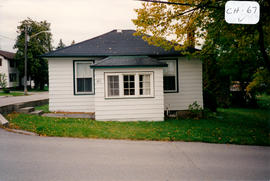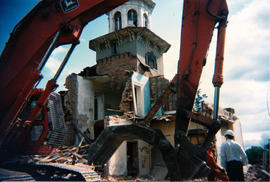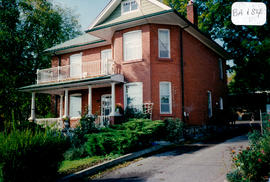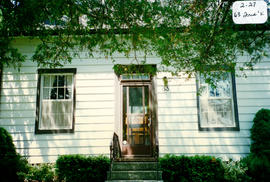162 Barrie Street - Professor Day House
- CA BWGPL GJ-HB-2017-03-14-06-2017-03-14-08
- Partiellement
- 1996
Fait partie de George Jackson fonds
The Professor Day House is located at 162 Barrie St. (on the northwest corner of Barrie and Queen Streets). It was built in the early 1880’s in the Gothic Revival Cottage style. Stables were originally located in the rear yard. Mrs. Creighton, a daughter of Dr. Stevenson, once lived here. A granddaughter, Gretchen Dewhurst, was still living here in 1996.
The 1½-storey, three-bay cottage has a 1½-storey, rear ‘kitchen’ wing. It also has a symmetrical façade, a centre hall plan, and a medium-pitched, gable roof with a centre gable over the entrance. An open porch with a gable roof is supported on plain wood posts with an open railing. The house has large window openings with high floor to ceiling heights. There are large double-hung, multi-paned windows at the ground floor and smaller, double-hung windows at the second floor. Shallow, pediment-shaped trim is found over the ground floor windows as well as plain, wood trim on the sides with wood slip sills. There are shutters at the windows on the front façade. The house has wood frame construction with painted, stucco cladding and a stone-rubble foundation and cellar. A stone chimney and fireplace were added in the 1950’s by Reverend Creighton. According to the 2000 inventory, the house is in excellent condition with many original features (including doors and windows). It also notes that the changes that have been made to the house are in keeping with its original character. (1, 3)
Please contact the Bradford West Gwillimbury Public Library (905-775-3328) if you have any other information about this photo.
Sans titre










